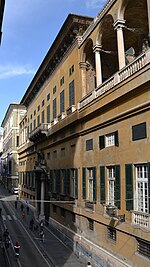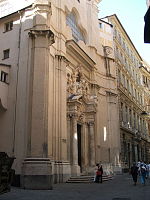Palazzo Balbi Piovera Raggio
Palaces in GenoaWorld Heritage Sites in Italy

The palazzo Francesco Maria Balbi Piovera' is a building located in via Balbi at number 6 in the historical centre of Genoa, included on 13 July 2006 in the list of the 42 palaces inscribed in the Rolli di Genova that became World Heritage by UNESCO on that date. The building, also known by the name of palazzo Raggio from the name of the armor who purchased it in the 19th century, is today the seat of the Faculty of Letters of the University of Genoa.
Excerpt from the Wikipedia article Palazzo Balbi Piovera Raggio (License: CC BY-SA 3.0, Authors, Images).Palazzo Balbi Piovera Raggio
Via Balbi, Genoa Prè
Geographical coordinates (GPS) Address Nearby Places Show on map
Geographical coordinates (GPS)
| Latitude | Longitude |
|---|---|
| N 44.414625 ° | E 8.927036 ° |
Address
Palazzo G. Agostino Balbi
Via Balbi
16100 Genoa, Prè
Liguria, Italy
Open on Google Maps











